Five Images of Fire in the Red Book
In exploring the symbolism of fire and spirit, several of the image in Jung’s Red Book came to mind.
The Red Book is, of course, an extraordinary and inspirational work; how Jung’s ability to engage with his deep psychological processes and express them through stunning images is remarkable.
In reviewing the images in the Red Book that contained fire, most of them involved “Incantations” — for me, one of the most readable yet mysterious aspects of the entire work
The incantations (or commentary) corresponding to each of the five images are included below.
C.G. Jung: About the Red Book
The years, of which I have spoken to you, when I pursued the inner images, were the most important time of my life.
Everything else is to be derived from this. It began at that time, and the later details hardly matter anymore.
My entire life consisted in elaborating what had burst forth from the unconscious and flooded me like an enigmatic stream and threatened to break me.
That was the stuff and material for more than only one life.
Everything later was merely the outer classification, the scientific elaboration, and the integration into life.
But the numinous beginning, which contained everything, was then.
C.G. Jung
Memories, Dreams, Reflections
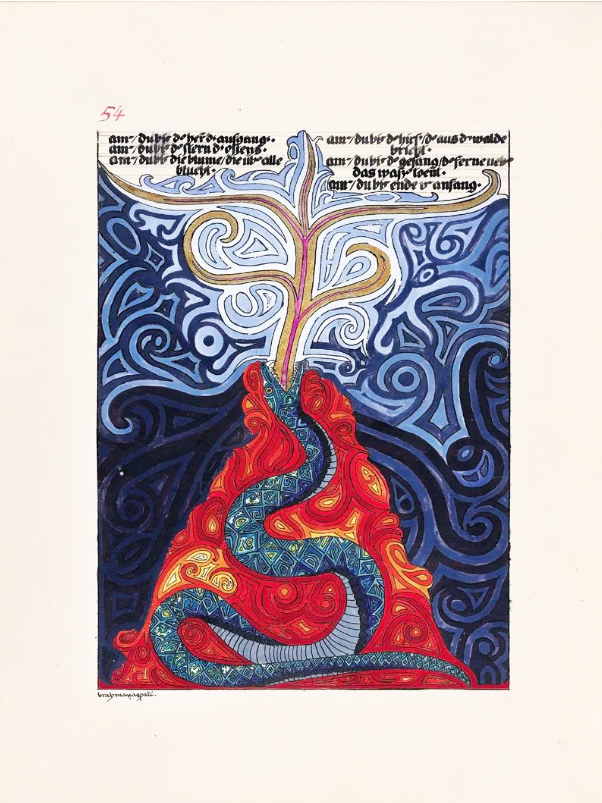
Amen, you are the lord of the beginning.
Amen, you are the star of the East.
Amen, you are the flower that blooms over everything.
Amen, you are the deer that breaks out of the forest.
Amen, you are the song that sounds far over the water.
Amen, you are the beginning and the end.
(Inscription at top of image)
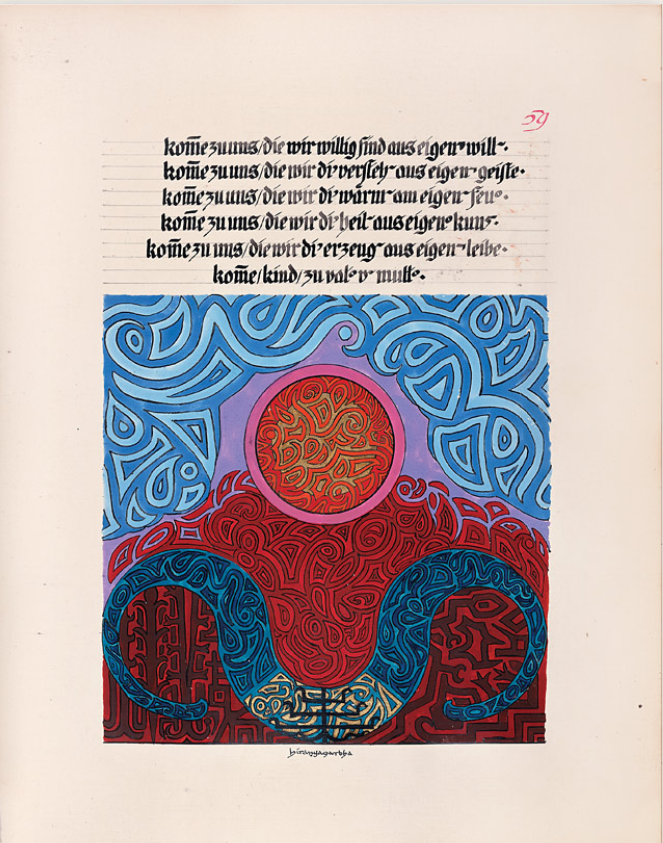
We asked earth.
We asked Heaven.
We asked the sea.
We asked the wind.
We asked the fire.
We looked for you with all the peoples.
We looked for you with all the kings.
We looked for you with all the wise.
We looked for you in our own heads and hearts.
And we found you in the egg.
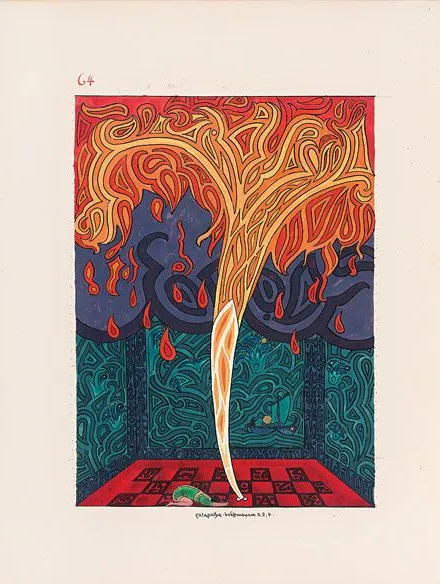
May your light shine before us, may your fire warm the coldness of our life.
We do not need your power but life.
What does power avail us?
We do not want to rule.
We want to live, we want light and warmth, and hence we need yours.
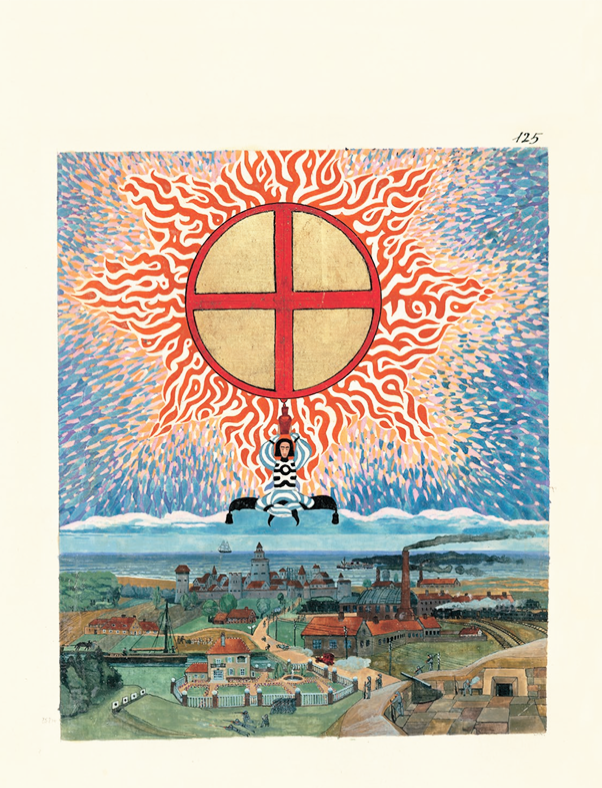
(From Jay Sherry, “A Pictorial Guide to the Red Book”)
“As he often did, Jung divided this picture into transcendental and mundane zones.
The upper zone is dominated by a radiating golden mandala while below he paints a Swiss landscape in a folk-art style.
The two are mediated by a yogi, eyes closed in meditation, holding a vase aloft.
The landscape can be further divided into left and right: the left shows the country’s rural side while the right shows its industrial reality.
Significantly, a strong wind is blowing from the left to keep the gritty smoke of modernity from polluting the traditional, pastoral world.
(From the Symbol Reader:)
The chapter is accompanied by Image 125.
In his invaluable footnotes Shamdasani explains that the scene depicted in the image resembles one of Jung’s childhood fantasies described in Memories, Dreams, Reflections
In it he imagined Basel to be a port and in his mind’s eye he saw a sailing ship on the waters of the Rhine.
The image here shows Atmavictu in deep meditation for details about him).
The Aquarian vessel on his head is being filled with divine prana or the water of the spirit, which emanates from the golden red solar mandala.
It seems that the ship from the childhood fantasy sails on the border between divine and mundane reality.
The orderly Swiss world below appears to be oblivious of the spiritual dimension depicted in the upper part of the image.
From Jay Sherry, “A Pictorial Guide to the Red Book”
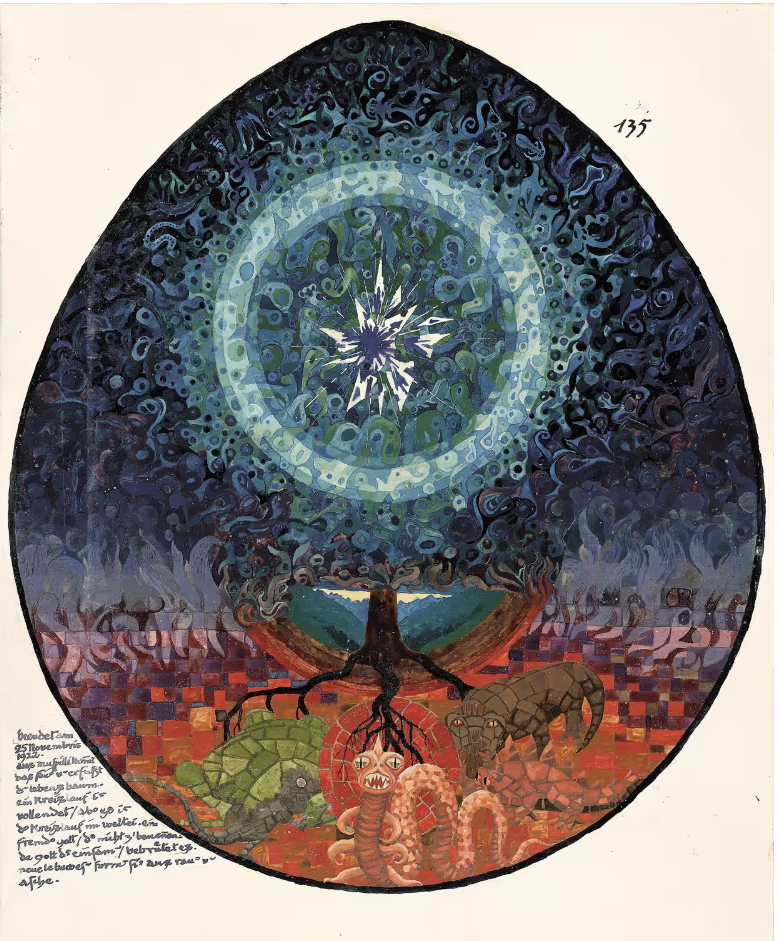
The fire comes out of Muspilli and grasps the tree of life. A cycle is completed, but it is the cycle within the world. A strange God, the unnamable God of the solitary, is incubating it. New creatures form from the smoke and ashes.
(Translation of bottom left)
Epilogue to the Red Book, 1959
I worked on this book for 16 years.
My acquaintance with alchemy in 1930 took me away from it.
The beginning of the end came in 1928, when Wilhelm sent me the text of the “Golden Flower,” an alchemical treatise.
There the contents of this book found their way into actuality and I could no longer continue working on it.
To the superficial observer, it will appear like madness.
It would also have developed into one, had I not been able to absorb the overpowering force of the original experiences.
With the help of alchemy, I could finally arrange them into a whole.
I always knew that these experiences contained something precious, and therefore I knew of nothing better than to write them down in a “precious,” that is to say costly book and to paint the images that emerged through reliving it all—as well as I could.
I knew how frightfully inadequate this undertaking was, but despite much work and many distractions I remained true to it, even if another possibility never …
Source: https://harpers.org/2009/10/inside-jungs-red-book-six-questions-for-sonu-shamdasani/
